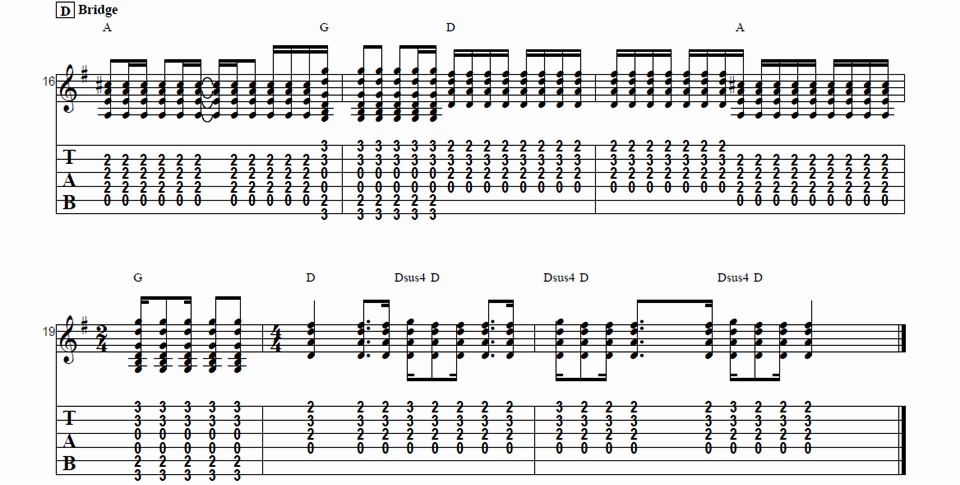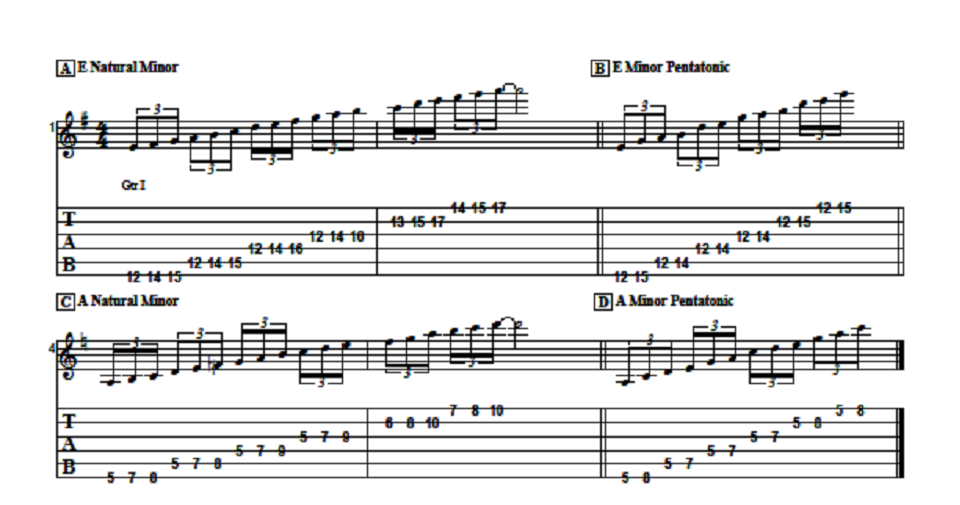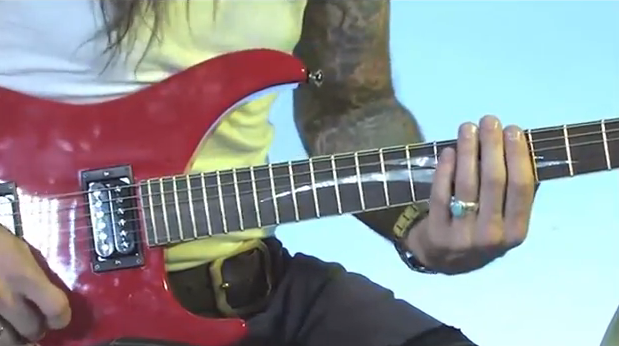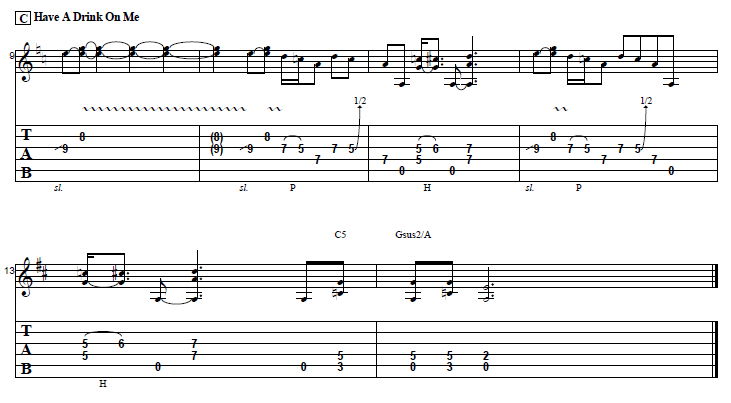Grab your acoustic guitar and learn to play this classic rendition of Signs by Tesla from the Five Man Acoustic Jam live album. This is a great tune and Guitar Control instructor Darrin Goodman, aka Uncle D breaks it down so its really easy to play, even if you are a beginner. So be sure to get the free tabs to go along with the video instruction and you will be rockin’ this tune by the fourth of July BBQ.



Introduction
How’s it going everybody? This is Darrin with GuitarControl.com bringing you this video lesson and today I want to show you how to play Tesla’s rendition of Signs by Five Man Electric Band.
So right now Guitar Control is giving away this really cool free chord chart, there’s a link down in the description where you can get yours. It has every chord you could ever need all neatly compiled on one sheet. It’s in PDF format so you can download it, you can print it off, you can put a copy in your gig bag, put a copy where you practice; so just whatever situation you could have any chord you needed to glance and it’s a free download.
So be sure to click the link in the description for the tabs and let’s get close up and take a look at this.
Signs – Tesla
All right, so we’re going to be for the most part just playing a bunch of just basic chords that you probably already know; hopefully you already know. All right, so we start with this D right on the downbeat of one and it’s a quarter note and then on the downbeat of two we strum it again. It’s an eighth note and then on the and of two it’s two sixteenth notes. So we’ve got a total of four strums; long, short, shorter. And then we’re gonna go to the D suspended four (Dsus4) and we hit that right on the downbeat of three, but then we immediately switch back to regular D for the remainder of the measure… right on the downbeat of one of the second measure we go back to the Dsus4, back to the D, so it’s kind of a pattern that just repeats… the very last one there right at the end of the second measure we’ve got just the A and the D string open and then to the second fret of the A string, but the D string is still open and these are like kind of pickup notes into the into the beginning of the verse and then we just drop into a regular C major chord…
All right, so now we’re on the verse… so the vocal start right there and we start with C and it’s just a regular regular open position C major chord; so I’m on the third fret of the A string, second fret of the D string, G string is open, first fret of the B string, high E string and we’re gonna play this starting on the downbeat of one with C. So how I’m doing is I’m just hitting the E, the A, the D and then the G and the B together; one and, two. Then we’re gonna go to a G over B (G/B) and this is really simple. All you have to do is take your middle finger and move it from the second fret of the D string to the second fret of the A string and take your other two fingers off so now you’re going to be playing the same thing, three and four… Then we’ve got a D over A (D/A). So if you just go back to the original D major chord, but now you’re just going to start off by hitting the open A and then the open D, one and two, and then to a G major chord, three and four…
So with that part it shows on the on the transcription you hit the E string and then the A, D and G strings and then the G, B and high E. So when you’re when you’re practicing that don’t put too much stress into like making sure that when you get to this top part that you don’t hit the D string. You know it it’s just not a big deal. All the notes are in the key they’re part of the chord. So over time you’ll refine it, but at first don’t put too much worry on that. All right, so far on the verse we’ve got… Now we’re going to switch to a D again, so this is like one, two… same thing like we did on the intro, it’s a quarter note, then an eighth note, then two 16th notes; so one, two e and, and then to an A major.
So when I do this I’m just using my first finger to barre because you don’t need to worry about hitting the high E string. So I’ve got the A string open and then I’m just barring the second fret of the D, G and B strings… and we hit that and then to a G, same thing… and
then two back to an A major and it’s the same as the timing at the second half of that previous measure with the A; so it’s two sixteenth notes, then an eighth, then four sixteenth notes…
Now as far as that strum and rhythm in there you can really kind of make it your own.
You just kind of want to feel it. I probably don’t play it consistently exactly the same way every time, there’s probably been slight variances. You just kind of want to feel it and you will always get a better performance if you kind of feel it then if you’re really trying to count it unless it’s some kind of a really syncopated rhythm that you need to be doing, especially on an acoustic song it just isn’t necessary to put that much stress. It will make this easy especially if you’re a beginner. Okay then we go to a B minor… so just barring the second fret my first finger the through the A string we don’t use the low E and then I’m on the second or excuse me the third fret of the B string on my second finger, fourth fret of the D string with my third finger, fourth fret of the G string with my fourth finger. Now when you play this you can get all of it or you could omit the high E string. So if you’re having problems with doing barre chords you can just get this shape here and then all you have to do is pick up the note on the A string and it’ll probably already be muting the high E string anyway just simply because of your finger laying down… So here we’re starting with B minor and we’ve got that similar kind of a rhythm thing going here. We’ve got one and, two… so we’ve got on beat number two the last 16th note is tied to the first 16th note of beat three, so it’s like treated like an eighth note. So if you thought of this as like three long, one short, one long, one short, one long, four short, as far as how they ring out, but again if you know the melody of the song like that we’ve talked about in lots of other videos about countertop drumming to get that for this B minor… Okay then we go to a G, so just regular old G major and whether you play it with the D note here on the third fret of the B string or you play it with the B string open. I personally like the way it sounds more with this D in there and I think that’s the way they’re playing it and Tesla’s playing in their version. So that’s the way I’ve got it in here, but if you don’t play G that way, it’s just not that big of a deal. For this with G here we got the same timing that we just had on the B minor then we’re gonna go back to a D and it’s back to this similar timing that we had earlier in the verse. So this is actually exactly the same as a measure five, so it’s back to the D, so long, one, two… and then to an A and on here it’s just… But again you don’t feel free to kind of like spice up that rhythm, especially if you’re playing this completely by yourself. They’re playing it as a whole group, but if you’re playing it by yourself you have a lot of freedom and you can really change up that rhythm and make it to sound more interesting and more fun for you to play as well.
All right, now that brings us to the chorus and for the chorus it’s going to be using the same G, D, A and C that we’ve been using except we have one more chord; we have a C add nine (Cadd9). So Cadd9 has a couple of different ways that you could play it. I’ll show you the way that I like to do it for this particular thing. I just think personally I think it makes it easier. So we’re gonna go from a D to the Cadd9; so if you just take your first finger and you move it down a string so it goes from the second fret of the G string the second fret of the D string and then your middle finger moves down so it’s on the third fret of the A string your ring finger stays where it is. So there’s a couple different ways you can play it, this is just the way they’re doing it. So you could also do it just by taking the regular C shape and putting your pinky down like this. The reason I do it the way that I do it is because after the Cadd9 we’re going to go to a G, so it just makes the transition really simple. So we’re going to go from this D to Cadd9 to G… So that’s the chorus and it starts off with the D; so we’re hitting this as a quarter note and then an eighth note to 16th to note. So the thing that’s different between this and what we’ve been doing is we’ve got the one, two e and, so that second sixteenth note of beat two is actually going to make the change to Cadd9. So it’s coming in kind of on in a weird place, especially if you’re doing it from trying to count it, but it just makes it a lot easier. So when we hit that it is on the last 16th note of beat two, but it’s tied to the first 16th note of beat three… So we hit that and then we hit it three more sixteenth notes and then we’re going to go to a G and that’s on the downbeat of four… Okay, then starting on the second measure we’re back to D. So we start with two 16th notes and then an eighth note… and then on the last 16th note of beat two we switched to a G… So we hitched that to G on the last 16th note of beat two and then we’ve just got four eighth notes; so three and four and… then we’re gonna go back to a D… then A same a we did earlier and now to our regular C chord. So the Cadd9 is basically the difference between those two chords is here we’re getting this C here we’re getting a D. So with all of these chord changes sometimes these different voicing’s are just so it carries a chordal melody, like a high melody within the chord or a low melody just depending upon what it is. So when we get to that C we have a whole measure of this; it’s one and, two e and, three e and a, four and. So again much easier if you just kind of feel it out and then it’s the end of a repeat so you play the intro, the verse, the chorus and then you go back and play the intro again, the second verse, the second chorus and then the end of the second chorus it has this little transition here that leads us into the bridge. So we’re at the end and this is kind of like the intro… Now we’ve got this little build up thing that is kind of weird, especially when you’re just playing this by yourself. It really makes it sound cool, at least for me. I find it maybe have of the time I do it sounds cool. So we’ve got the eighth notes, beat number one and beat two are eighth note, two sixteenth note, so one and, two e and, and then on the downbeat of three the first sixteenth note is the strum of that. And then we have an eighth note just a single G third fret of the low E string and we’re gonna hit that twice as eighth note and then a sixteenth note and then we have a sixteenth note rest. And then the next sixteenth note is the fourth fret, so we rest a sixteenth note and go to an A because that’s like… that was okay, it sounds really cool when they do it, but just by yourself it’s not a full sounding in my opinion.
Okay, so the very last thing we’re hitting is that that strumming in A and it’s the last 16th note of beat four and then that brings us into the bridge, which starts on A. So we’re already there. We’ve got one e and, so like an eighth and two sixteenth notes and then an eighth, two sixteenth and the very last 16th note of beat two is tied to the downbeat of beat three so it’s an eighth note. Again, don’t put too much thought into that. Just kind of feel it… We’re going to do this through the whole measure and then the last 16th note we switch to a G… starting on the downbeat of two it’s a G and it’s the same timing again. We’ve got one and, two and, and we go to a D major… The third measure starts off with 16th notes and the last 16th note of beat we switched to an A and then we have two beats, eight sixteenth notes for beats three and four… then back to a G, this is a two four barre so it’s just two beats; one, two, three, four, five… that’s one way you can simplify it, and now to a D… so it’s just like the intro. Okay so then you have the verse, “the sign says come in kneel down and pray”, the church one and it’s a lot softer and the acapella parts, but it’s all just more or less these same parts that we’ve gone over.
Conclusion
All right, there you have it, all the parts to be able to play Signs, Tesla’s version of Signs by Five Man Electric Band, I think it was called originally. So if you like this lesson be sure to give me a thumbs up and leave a comment down below if you have any questions about this or other guitar related topics. If you’ve not already done so please subscribe to the channel and hit that notification bell so you don’t miss any of the content we upload throughout the week. Well that is all I have for you today. Thanks for watching and have a great day.




